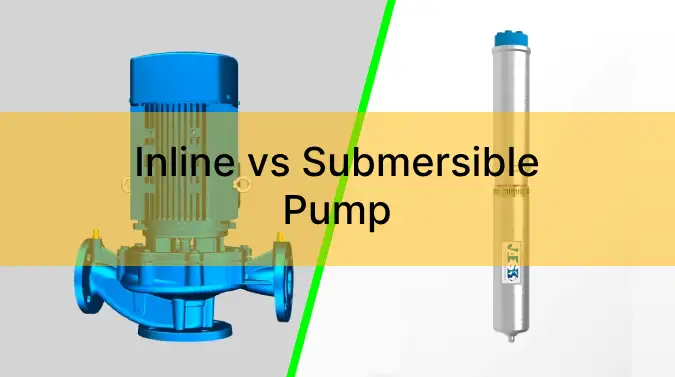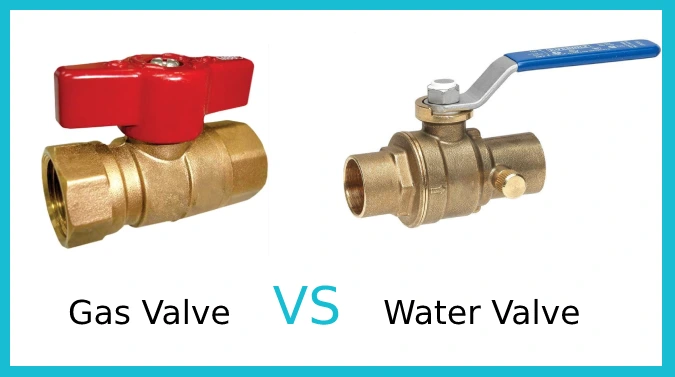Last Updated on July 14, 2023
In water pumping systems, choosing the right type of pump is crucial for efficient and effective operation. Inline and submersible pumps are two common types of pumps used in various applications, including hydroponics, aquaponics, and irrigation systems.
Inline pumps, also known as external pumps, are installed outside the water source. They are typically used for high-pressure applications where water needs to be moved quickly and efficiently.
On the other hand, submersible pumps are designed to be placed directly in the water source. They are often used in applications where the water needs to be completely emptied, such as in a sump pump or a pool pump.
Let’s discuss more about these two types of pumps and their uses.
The Differences Between Inline vs Submersible Pump

Inline and submersible pumps have some key differences to take into consideration when choosing one.
- No 01: Cooling Method
- No 02: Placement
- No 03: Heat Dissipation
- No 04: Space and Noise
- No 05: Handling On/Off Cycles
- No 06: Application
- No 07: GPH Amount
No 01: Cooling Method
Submersible pumps are much more reliable than inline pumps because they are cooled by the water they sit in, ensuring they never overheat. This cooling method is highly effective as the water continuously flows around the motor, preventing any build-up of heat that could cause damage to the pump.
The water also acts as a lubricant, reducing wear and tear on the motor and other components.
On the other hand, inline pumps require external cooling and are air-cooled. This cooling method is not as effective as submersion cooling because air is not as efficient at dissipating heat as water. As a result, inline pumps are more prone to overheating and can suffer from reduced performance and increased wear and tear.
No 02: Placement
When you are deciding where to place your water pump, keep in mind that submersible pumps have a higher efficiency rate, with an average of 70 to 80% compared to inline pumps. This is due to the fact that submersible pumps are fully submerged in water, which helps them to cool down and ultimately perform better.
Additionally, submersible pumps are more compact and can be installed directly into a well or reservoir, making them less likely to suffer from leaks and requiring less maintenance overall.
Conversely, inline pumps are placed outside the reservoir or may not have a reservoir at all. This can make them more susceptible to overheating, especially if they are located in a hot environment or exposed to direct sunlight.
No 03: Heat Dissipation
To keep your water cool and prevent overheating, you’ll want to consider ways to dissipate the heat generated by your pump.
Submerged pumps are immersed in water and dump the heat they generate directly into the water. This can cause a significant increase in water temperature, which can negatively impact aquatic life and promote the growth of harmful algae.
Due to the fact that inline pumps are placed outside the water, they have a much smaller impact on water temperature.
Heat dissipation is particularly important in warm climates or during the summer months, when water temperatures are naturally higher.
Submerged pumps can contribute to a vicious cycle of increasing water temperature, as the warmer water can cause the pump to work harder, generating even more heat. By contrast, inline pumps can help maintain a more stable water temperature and prevent overheating.
No 04: Space and Noise

You can save space and reduce noise by considering an inline pump that sits on the ground next to your water source.
By being placed outside the reservoir, inline pumps do not take up space within the tank, making them ideal for smaller spaces. This also allows for easier access and maintenance, as well as a more straightforward installation process.
Submerged pumps are often quieter than inline pumps. And, since they are located within the reservoir, they do not generate any additional noise.
No 05: Handling On/Off Cycles
If you’re looking for a pump that can handle frequent usage, it’s important to consider how it can withstand the ebbs and flows of your water usage patterns. This is especially true when it comes to handling on/off cycles.
Submersible pumps are generally more forgiving in this area, as they are designed to be submerged in water. This means that they can handle being turned on and off more frequently without experiencing damage or wear and tear. On the other hand, larger inline pumps may struggle with frequent on/off cycles.
No 06: Application
When it comes to the application, inline pumps are typically used for larger operations that require a higher flow rate of at least 30 gpm. They’re best suited for applications that require constant pressure and flow, such as HVAC systems, large irrigation systems, and industrial processes.
Additionally, inline pumps are suitable for applications where the pump must be located outside of the fluid being pumped. They can be easily installed in the piping system. In contrast, submersible pumps are commonly used in smaller systems that don’t require a high flow rate.
They’re ideal for applications that require the pump to be submerged in the fluid being pumped, such as in a sump or wastewater treatment system.
Submersible pumps are also suitable for applications that require a lower noise level, as they’re typically quieter than inline pumps. In general, when considering the application, it’s important to choose the type of pump that’s best suited for your specific needs.
No 07: GPH Amount
For systems that require a total GPH of 1200 or less, submersible pumps are the way to go. These pumps are designed to be completely submerged in the water, making them ideal for small-scale operations such as aquariums or fountains.
On the other hand, if your system requires a higher flow rate, then you’ll need an inline pump. These pumps are designed to be installed outside of the water, typically on the ground or mounted to a wall.
Inline pumps can handle a much higher flow rate than submersible pumps, making them ideal for larger operations such as water features or irrigation systems.
Comparison Table between Inline and Submersible Pump
| Criteria | Inline | Submersible Pump |
| Cooling Method | Air-cooled | Water-cooled |
| Placement | Located on the ground next to the water source | Immersed directly in the water |
| Heat Dissipation | Puts some heat back into the water | Emits heat into the water |
| Space and Noise | Space-saving advantage may produce more noise | Takes up space in the reservoir, generally quieter |
| Handling On/Off Cycles | May not handle frequent on/off cycles well | More forgiving when turned on/off by a timer |
| Application | Suited for larger operations, higher flow rates | Suitable for smaller systems limited flow rates |
| Pump Selection | Chosen for higher flow rates | Suitable for lower flow rates |
Can I use an inline pump for a small hydroponic or aquaponic system?
While inline pumps are typically recommended for larger operations, they can certainly be used for smaller systems if the flow rate requirements are met and the pump can be conveniently placed next to an above-ground tank.
An inline pump is designed to be installed along the pipeline, allowing water to flow through it and out to the plants. This type of pump is typically easier to access and service than a submersible pump, which must be removed from the water in order to be maintained.
When choosing an inline pump for your hydroponic or aquaponic system, it’s important to consider the flow rate needed to adequately water the plants. The flow rate should be matched to the size of the system, as well as the water requirements of the plants being grown.
It’s also important to ensure that the pump is able to handle any potential clogs or blockages that may occur in the system, as this can cause damage to the pump and affect the performance of the entire system.
Are submersible pumps more energy-efficient than inline pumps?

Energy efficiency is a crucial factor to consider when choosing a pump for your hydroponic or aquaponic system. Regarding inline pumps vs submersible pumps, it’s important to note that both types of pumps can be energy-efficient.
However, submersible pumps tend to be more efficient due to their design. A submersible pump can be positioned instantly into the water, which means they don’t have to pump water as far as inline pumps.
This shorter distance reduces the amount of energy needed for the pump to function, making it more energy-efficient.
Additionally, submersible pumps require less maintenance than inline pumps since they are protected from debris and other elements that can cause damage.
This means that submersible pumps are not only more energy-efficient but also more cost-effective in the long run.
Choose the Right Pump: Inline or Submersible
The choice between an inline pump and a submersible pump is dependent on the unique requirements of your water pumping system.
An inline pump may be the better choice if you’re running a larger operation that calls for a high flow rate and constant pressure. On the other hand, if you have a smaller system that needs a lower flow rate and quieter operation, submersible pumps are ideal.
Submersible pumps also have an advantage in terms of space-saving installation, efficient cooling, and capacity to handle frequent on/off cycles. Energy efficiency-wise, submersible pumps have a slight advantage due to their shorter pumping distance.
Therefore, to ensure the best performance and efficiency, select the pump that best fits the requirements of your application.



